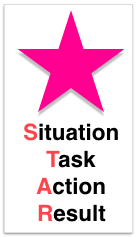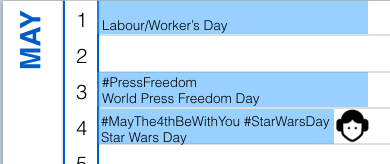
I’ve spent a fair bit of time interviewing people over my career, and last year I spent a lot of time being interviewed or preparing for interviews, including the behavioural interview. Behavioural interview questions are designed to help the interview understand how you work. They usually begin with;
- How did you…
- Describe a situation when…
- Give me an example of…
- What did you do when…
They can feel hard to answer and unpredictable, in fact they’re neither.
Answering Behavioural Questions
There is a way to answer the questions that is easy to prepare for, simple to remember, and relatively quick to deliver. It’s the STAR method.
 Situation; Outline the situation that you were acting in
Situation; Outline the situation that you were acting in
Task; The outcome you needed to achieve
Action; The action or actions you took
Result; The outcome, be clear on what your actions contributed to the outcome, don’t be afraid to take credit for your work. Also be prepared to answer that the result wasn’t as expected if that’s the truth, but then clarify why you didn’t achieve the result you expected.
Here’s how I developed a STAR response to a potential question
| Question |
Describe a decision you made that was unpopular and how you handled implementing it.
|
| Situation |
I was responsible for implementing a new tool to replace old personnel directory, the new tool was better in many ways but did not have all the same functionality. Two groups were unhappy about this decision.
|
| Task |
1: Secretaries wanted their contact information connected to their bosses’ profile
2: A group wanted to search by partial phone number, the last four digits |
| Action |
1: We could assess this as valuable for bosses, secretaries and useful for all staff, we implemented this change as a priority
2: We looked at the data and found this was a rare search, we decided not to implement it and explained our decision |
| Result |
1: Secretaries happy, this was a good change and a requirement we’d missed.
2: There were some complaints about our decision for about 10 days. No reaction beyond that. |
Usually I only use one situation per response, but in this case I choose to use two as one shows that where other people raise good reasons to alter my view I will change, and the other shows that I can hold my ground when there are no good reasons to change.
Most of my responses were from work situations, but you can use your experience from volunteering organisations, University groups, schools, and your personal life.
Creating this response ahead of an interview means that you will be prepared when the question comes up during the interview, and it will be easy for you to recall the situation and retell the story to the interviewers.
Predicting Behavioural Questions
It might seem that there are an infinity of possible questions an interviewer might ask, but in reality the interviewer is looking for someone to match the job requirements so my first source of behavioural questions is the job vacancy notice. The examples below are all from current vacancy notices for various communications roles on LinkedIn.
| Job Vacancy Notice |
Behavioural Question |
| A track record of rapidly expanding the reach of social media accounts |
How did you grow the reach of one or more social media accounts? |
| Identify and act upon communications issues whilst keeping senior management informed |
How have you managed the communications around a crisis or a company issue? |
| Manage relations with external contacts and key stakeholders within the business |
Describe a situation where you managed the conflicting demands of different stakeholders. |
| Leading cross-functional project teams to design, deliver, test and successfully roll-out multi-channel projects. |
Give me an example of a project you led, that delivered across multiple channels. |
Note that the question on the right doesn’t include all of what they have said they were looking for in the vacancy notice, but by analysing and planning your responses you’ll cover much more of what they are looking for.
For each item on the vacancy notice that points to activities in your new role design questions and STAR method responses.
I did this for all the vacancies I applied for, and I researched online for common behavioural questions and found multiple lists that cover more generic job requirements such as handling conflict, managing deadlines, learning new skills and motivating others. I made a list with all the questions I came up with and filled in my STAR method responses to create a tool that helped me in my job search.
I then practised telling those stories sometimes to myself (yes, I do talk to myself) and sometimes with a friend, until I could tell the stories in a natural way. I really do recommend practising with someone, it’s hugely helpful.
Tricky Questions
You can predict the behavioural questions and plan your answer, when you’ve practised your responses a few times you’ll be able to adapt your response for various ways interviewers pose the question. But there are a couple of ways you could still get tricky questions.
If you don’t have a situation that matches a behavioural question for the job, say what you would do, for example;
How have you managed the communications around a crisis or a company issue?
I have not had to do this in previous roles, based on my experience in customer care I would …
If you have used one situation to cover more than one Behavioural Question, and you get asked both, refer to your previous answer and take the opportunity to expand on it, for example
Give me an example of a project you led, that delivered across multiple channels.
As I mentioned regarding the Gemini Project, I lead a project that developed multiple forms of content for a range of audiences, let me explain further how we used those for different channels…
If the result wasn’t as good as expected, you can still use the example, but explain why the result was different. For example;
How did you grow the reach of one or more social media accounts?
Our Twitter account had few followers, and our goal was to build those numbers to half a million by year end. We began by building a strong content calendar, and increasing the rate of tweeting from once a day to 4-8 times per day, and repeating content for different timezones. We then ran a series of targeted paid campaigns aimed at increasing our follower numbers, with each sprint we analysed what had worked and adjusted the campaign. At the end of the year we made it to 417,000 which was a great result, but short of our goal. We severely underestimated the amount of paid advertising we would need to commit to, and it was only a late increase in spending that got us over the 400,000 mark.
Preparing well for interviews means you can present yourself in your best light, showing your expertise and demonstrating effective communication skills. That means doing the work; planning for your interview, thinking how you will respond, and practising those responses.
Here’s my list of Behavioural Interview Questions, feel free to download it and adapt it for your own job search. Fill in your own responses and find a friend to practice retelling your responses to. Let them go off script – after all your interviewer is working from their own script.
Good luck!
Image: Banner Question Mark | geralt | CC0 1.0


 I’m working one for the evolution of our intranet/digital workplace. I need to think about all the activities people do online, all the tools that fulfil those needs and what development is being thought of for the tools. For added fun, quite a lot of these tools aren’t strictly speaking my responsibility.
I’m working one for the evolution of our intranet/digital workplace. I need to think about all the activities people do online, all the tools that fulfil those needs and what development is being thought of for the tools. For added fun, quite a lot of these tools aren’t strictly speaking my responsibility.



 A
A 











